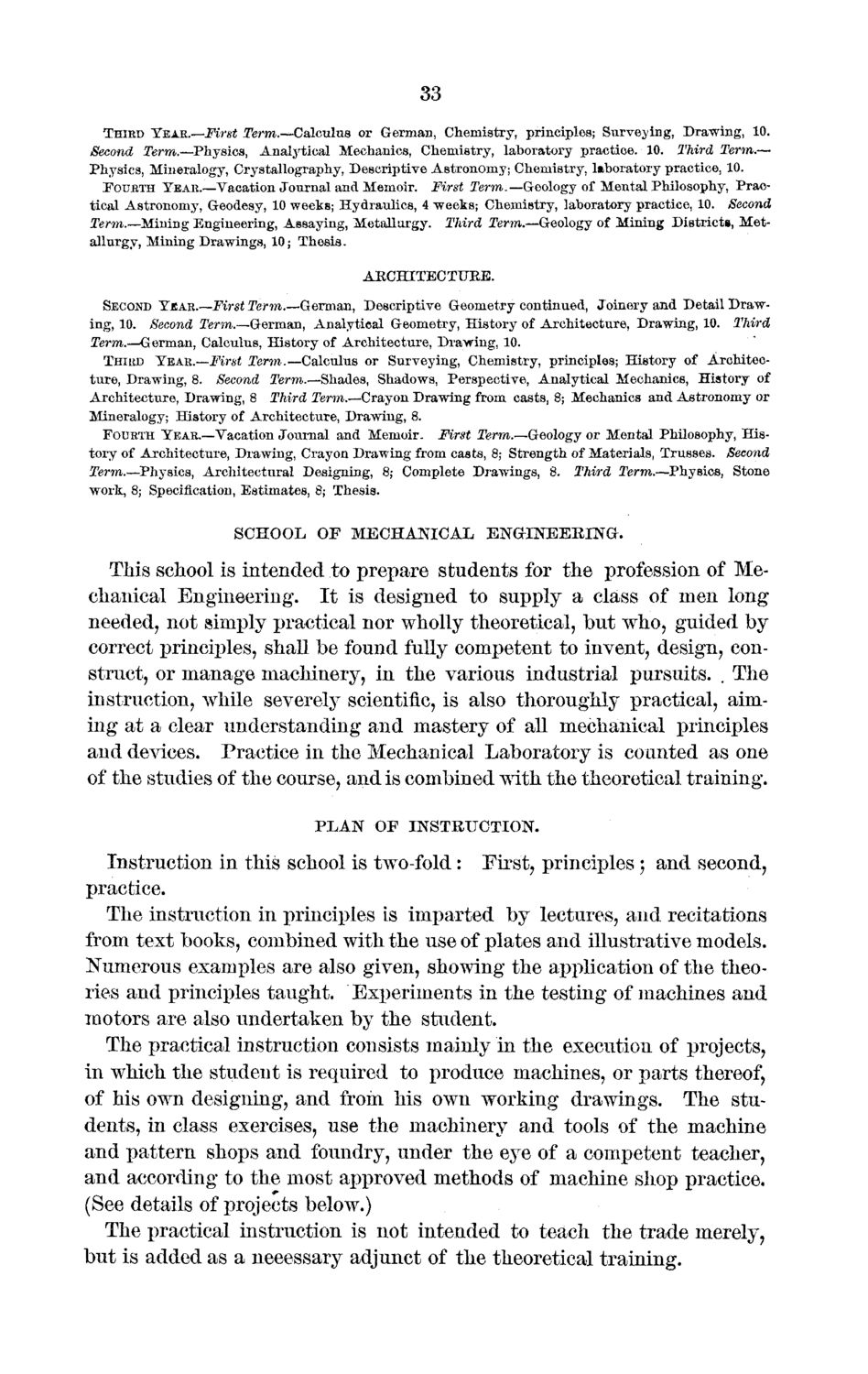| |
| |
Caption: Board of Trustees Minutes - 1872
This is a reduced-resolution page image for fast online browsing.

EXTRACTED TEXT FROM PAGE:
33 THIRD YEAR.—First Term.--Calculus or German, Chemistry, principles; Surveying, Drawing, 10. Second Term.—Physics, Analytical Mechanics, Chemistry, laboratory practice. 10. Third Term.— Physics, Mineralogy, Crystallography, Descriptive Astronomy; Chemistry, laboratory practice, 10. FOURTH YEAR.—Vacation Journal and Memoir. First Term.—Geology of Mental Philosophy, Practical Astronomy, Geodesy, 10 weeks; Hydraulics, 4 weeks; Chemistry, laboratory practice, 10. Second Term.—Mining Engineering, Assaying, Metallurgy. Third Term.—Geology of Mining Districts, Metallurgy, Mining Drawings, 10; Thesis. ARCHITECTUKE. SECOND YEAR.—First Term.—German, Descriptive Geometry continued, Joinery and Detail Drawing, 10. Second Term.—German, Analytical Geometry, History of Architecture, Drawing, 10. Third Term.—German, Calculus, History of Architecture, Drawing, 10. THIRD YEAH.—First Term.—Calculus or Surveying, Chemistry, principles; History of Architecture, Drawing, 8. Second Term.—Shades, Shadows, Perspective, Analytical Mechanics, History of Architecture, Drawing, 8 Third Term.—Crayon Drawing from casts, 8; Mechanics and Astronomy or Mineralogy; History of Architecture, Drawing, 8. FOURTH YEAR.—Vacation Journal and Memoir. First Term.—Geology or Mental Philosophy, History of Architecture, Drawing, Crayon Drawing from casts, 8; Strength of Materials, Trusses. Second Term.—Physics, Architectural Designing, 8; Complete Drawings, 8. Third Term.—Physics, Stone work, 8; Specification, Estimates, 8; Thesis. SCHOOL OF MECHANICAL ENGINEERING. This school is intended to prepare students for the profession of Mechanical Engineering. It is designed to supply a class of men long needed, not simply practical nor wholly theoretical, but who, guided by correct principles, shall be found fully competent to invent, design, construct, or manage machinery, in the various industrial pursuits. . The instruction, while severely scientific, is also thoroughly practical, aiming at a clear understanding and mastery of all mechanical principles and devices. Practice in the Mechanical Laboratory is counted as one of the studies of the course, and is combined with the theoretical training. PLAN OF INSTRUCTION. Instruction in this school is two-fold : First, principles 5 and second, practice. The instruction in principles is imparted by lectures, and recitations from text books, combined with the use of plates and illustrative models. Numerous examples are also given, showing the application of the theories and principles taught. Experiments in the testing of machines and motors are also undertaken by the student. The practical instruction consists mainly in the execution of projects, in which the student is required to produce machines, or parts thereof, of his own designing, and from his own working drawings. The students, in class exercises, use the machinery and tools of the machine and pattern shops and foundry, under the eye of a competent teacher, and according to the most approved methods of machine shop practice. (See details of projects below.) The practical instruction is not intended to teach the trade merely, but is added as a necessary adjunct of the theoretical training.
| |